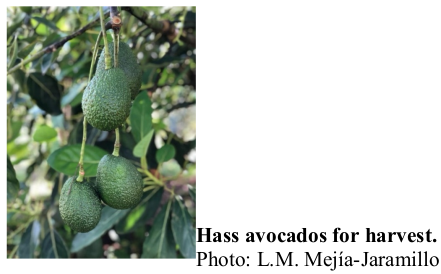Removal of macronutrients in the avocado fruit cv. Hass in Antioquia and Caldas, Colombia

Abstract
In recent years, Colombia have become globally as one the major producer of Hass avocado. Contributions of all nutrients are made in the fertilization plans, but it is not known if the additions made have been adequate and opportune. Thus, the objective of this study was to determine the effects of site and year of productions on the removal of nutrients during the harvest stage of different tissues of the Avocado fruit cv. Hass in two farms (El-Sinaí and La-Escondida) located in the high-Andean tropical zone of Colombia in three years of production (2018-2020). For this purpose, fruit samples were taken at the harvest stage of highly productive trees from two sites in Colombia (i) El-Sinaí (Anserma, Caldas; altitude 2,000 m, average annual temperature and precipitation 18.65°C and 1,837 mm) and (ii) La-Escondida (Rionegro, Antioquia; altitude 2,200 m, average annual temperature and precipitation 16.84°C and 2,091 mm). The fruit tissues (peel, pulp, seed-coat and seed) were subjected to elemental composition analysis. Significant (P<0.05) differences were detected for each element between tissues, years, sites and their interactions. The total removal range for macronutrients was: N 1.53-2.57, P 0.21-0.38, K 2.53-3.51, Ca 0.20-0.56, Mg 0.15-0.24 and S 0.13-0.18 (kg t-1). These results indicate that the order of nutrient accumulation in the fruit was K > N > Ca > P >Mg > S and they may be used as a reference for elaboration of fertilization programs in the regions studied, particularly in terms of the doses and ratios of nutrients. Also, the nutrient concentration in the different fruit tissues may be used as a reference of fruit nutritional status of productive trees for farmers interested in monitoring and improving nutritional of low-yield trees.
Keywords
Persea americana L., Fertilization, Nutritional status, Plant requirements
References
- Bhandari, N. and A. Lucas. 2018. Techniques used in plant tissue analysis for essential elements on horticultural plants and correlate with nutrient requirement. North American Academic Research 1, 94-113.
- Corpocaldas. 2020. Plan de gestión ambiental regional 2020-2031. Manizales, Colombia.
- Hofman, P., J. Bower, and A. Woolf. 2013. Cosecha, empaque, tecnología postcosecha, transporte y procesamiento. pp. 489-540. En: Schaffer, B., B.N. Wolstenholme, and A.W. Whiley (eds.). El Aguacate: botánica, producción y usos. Ediciones Universitarias de Valparaíso, Valparaíso, Chile.
- Holdrige, L.R. (1967) Life zone ecology. Tropical Science Center, San Jose.
- IGAC, Instituto Geográfico Agustín Codazzi. 2007. Estudio general de suelos y zonificación de tierras. departamento de Antioquia. Tome 3. Bogota.
- Juya, I. and K. Rivillas. 2019. Posibles fuentes potencializadoras de la diversificación exportadora para el crecimiento económico colombiano. Undergraduate thesis. Universidad EAFIT, Medellin, Colombia.
- Maldonado, R., M. Álvarez, G. Almaguer, A. Barrientos, and R. García. 2007. Estándares nutricionales para aguacatero ‘Hass’. Rev. Chapingo Ser. Hortic. 13(1), 103-108.
- Mellado, A., s. Salazar, A. Álvarez, M. Ibarra, and J. González. 2015. Remoción de nutrimentos por el fruto de aguacate ‘Méndez’ en el sur de Jalisco, México. pp. 376-379. In: Proc. 8th Congreso Mundial de la Palta. Lima.
- Minagricultura. 2021. Cadena productiva aguacate. In: https://sioc.minagricultura.gov.co/Aguacate; consulted: July, 2022.
- Osorio, N.W. 2018. Manejo de nutrientes en suelos del trópico. Universidad Nacional de Colombia, Medellin, Colombia.
- Ramírez-Gil, J.G., J.H. López, and J.C. Henao-Rojas. 2020. Causes of Hass avocado fruit rejection in preharvest, harvest, and packinghouse: economic losses and associated variables. Agronomy 10, 8, 1-13. Doi: https://doi.org/10.3390/agronomy10010008
- Rebolledo-Roa, A. and R.A. Burbano-Díaz. 2023. Nutrient balance in hass avocado trees as a tool to optimize crop fertilization management. Agronomy 13, 1-19. https://doi.org/10.3390/agronomy13081956
- Salazar, S. 2002. Nutrición del aguacate, principios y aplicaciones. INPOFOS; INFAP. Queretaro, Mexico.
- Salazar, S., I. González, and L. Tapia. 2011. Influencia del clima, humedad del suelo y época de floración sobre la biomasa y composición nutrimental de frutos de aguacate “Hass” en Michoacán, México. Rev. Chapingo Ser. Hortic. 17(2), 183-194.
- Snijder, B., M. Penter, J. Mathumbu, and F. Kruger. 2002. Further refinement of ‘Pinkerton’ export parameters. South Afr. Avocado Grow. Assoc. Yearb. 25, 51-55.
- Tamayo, A., J. Bernal, and C. Díaz. 2018. Composition and removal of nutrients by the harvested fruit of avocado cv. Hass in Antioquia. Rev. Fac. Nac. Agron. Medellin 71(2), 8511-8516. Doi: https://doi.org/10.15446/rfna.v71n2.71929
- Tamayo-Vélez, A., J.A. Bernal-estrada, C.A. Díaz-Díez, L.E. Cano-Gallego, and O.J. Córdoba-Gaona. 2022. Effect of rootstock/scion compatibility on fruit and foliar nutrient composition in avocado (Persea americana Mill.) cv. Hass in Colombia. Rev. Colomb. Cienc. Hortic. 16(3), e14833. Doi: https://doi.org/10.17584/rcch.2022v16i3.14833
